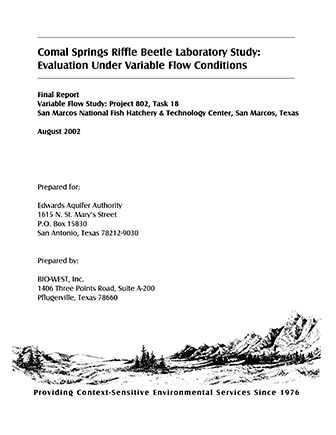Comal Springs Riffle Beetle Laboratory Study Evaluation Under Variable Flow Conditions

| Author | BIO-WEST Inc |
| Year | 2002 |
| Description | Laboratory study of the Comal Springs Riffle beetle under varying horizonal and vertical flow conditions |
| Report Number | San Marcos National Fish Hatchery & Technology Center Project 802, Task 18 |
| Publisher | BIO-WEST Inc |
| Location | Comal Springs (Laboratory) |
| Cover | View Download |
| File | View Download |
| Summary |
|
[from the Executive Summary] BIO-WEST conducted laboratory experiments to evaluate the habitat use of the endangered Comal Springs riffle beetle, Heterelmis comalensis. A paucity of data regarding physiological and ecological needs of the insect limits ones understanding of its habitat and necessitates basic research of the species. This study expanded upon recent field efforts by BIO-WEST, which revealed an Because the Comal Springs riffle beetle is found outside of the spring runs, it may be able to occupy more habitat than previously believed; this may also help explain the persistence of the species during periods of drought, particularly in 1956 when Comal Springs ceased flowing for 5-months. Nevertheless, the tendency of the species to congregate in areas of spring upwelling raises questions about how individuals react to a significant reduction or cessation of flow. It has been suggested that individuals retreat into springheads during such periods of low-flow. Under these conditions, water movement will attenuate and springflow may only be detected in subterranean habitats. It is also possible that a portion of the population regularly occupies interstitial spaces below the uppermost layer of gravel and rock that has been sampled exclusively to date. To examine this issue, an experimental representation of the natural habitat was designed and the response of the Comal Springs riffle beetle to water flow of varying intensities and with different Although results revealed no statistically significant conclusions, the beetles displayed tendencies for movement downward and towards current. All trials with the surrogate and the first two trials with the Comal Springs riffle beetle had similar results; the beetles all congregated on or near the bottom regardless of conditions. To account for a potential oversimplification of the natural habitat The tendency of the Comal Springs riffle beetles to orient toward flow confirms field observations that the species associates with flowing water. The overwhelming tendency for the beetles to move downward during the first two trials was hardly conclusive, but trials with highly restrictive barriers (i.e., 1-5% passable) provide evidence to suggest that individuals will search for moving water when it cannot be detected near the surface. With the barriers, upwelling flow would have been severely restricted and likely detected only by individuals once they had moved to the lower levels, yet most beetles were found there. In contrast, trials with only lateral flow across the upper layers had more beetles in those layers; the beetles presumably did not move to lower layers in search of the requisite flow. Finally, a trial with flow decreasing to zero over time and barriers in place resulted in a higher frequency of beetles in the lower layers in the trial with horizontal flow throughout. If these observations translate to behavior in the natural habitat, it is likely that individuals would respond to decreasing flow by retreating into more subterranean habitats. Further, it is possible that individuals may inhabit areas deeper in the gravel and sediment around spring orifices than have been previously sampled. It is important to note that these results may be affected by a number of factors that remain unknown about the species and were unaccounted for in this experiment. Dietary needs, reproductive behavior, etc., also may have influenced movement. In the natural habitat, niche division (intra- or interspecific competition) and predator avoidance may also largely determine habitat selection. Very little is known about this insect and more research is necessary to discern how it would behave under different flow conditions in its natural habitat. |
Search for Documents
Advance Search
Explore EAA's Scientific Reports
- All Reports
- Weather Modification
- Geology
- Water Use and Conservation
- Geochemistry
- Water Resources Planning and Management
- Floods and Drought
- Water Quality
- Climatology
- Surface Water / Groundwater Relationship
- Biology
- Springs, Groundwater Discharge
- Archaeology
- RZ Protection
- Aquifer Levels
- Remote Sensing
- Precipitation
- Overview Studies
- Modeling
- Hydrology and Hydrogeology
- History
- Groundwater Recharge, Recharge Zone
- Groundwater Movement
- Geomorphology and Caves
